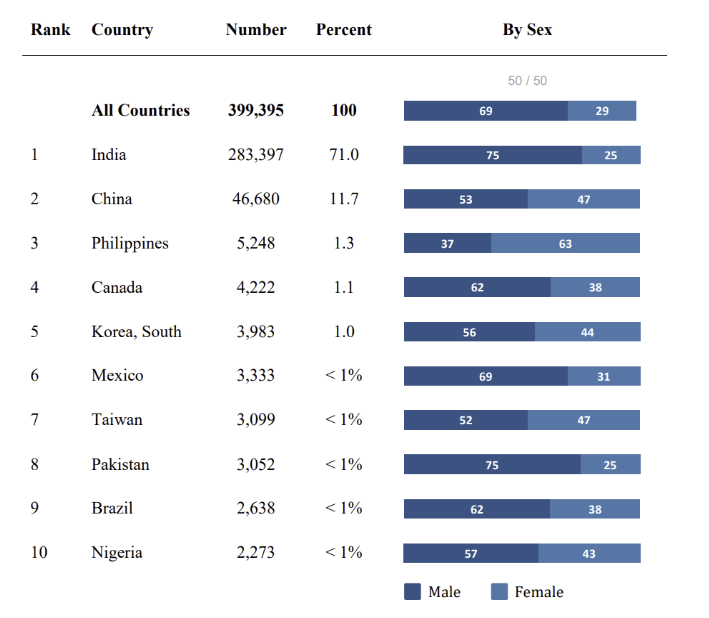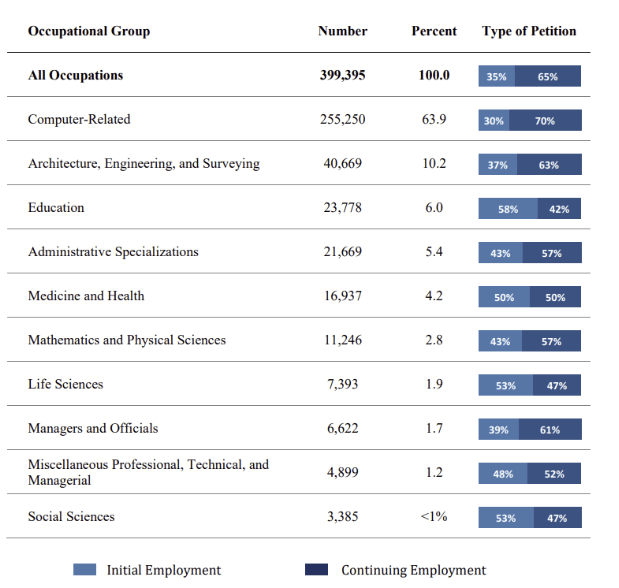Table of Contents
Listen to article
On Friday, Sept. 19, 2025, President Donald Trump signed a proclamation requiring companies to pay a $100,000 fee for new H-1B visa petitions.
Unsurprisingly, this has raised concerns among companies that depend on highly skilled international talent. Big tech companies are especially affected, as computer-related occupations accounted for 63.9% of all approved H-1B petitions in 2024.
With roles like software developers, AI engineers, and UX designers feeling the impact of this H-1B visa program update, companies face the challenge of meeting business goals while controlling labor costs—making outsourcing an increasingly strategic option.
Today, we’re discussing something that all companies should consider: how H-1B visa changes may affect them and the role outsourcing plays in modern businesses.
What is the H-1B visa?
The H-1B visa is a nonimmigrant U.S. visa that allows employers to temporarily hire foreign workers in specialty occupations requiring specialized knowledge and at least a bachelor’s degree or equivalent.
According to the U.S. Department of Labor, the program is intended to help employers address skill shortages in the domestic workforce by authorizing the temporary employment of qualified foreign professionals.
Demographic Trends in the H-1B Program
To better understand who is most affected by the new rules of the H-1B visa, we have to understand who the typical holders of this visa are.
The Department of Homeland Security prepared a report for 2024, giving us valuable insight into the country of origin and occupation of H-1B beneficiaries.
Top Ten Countries of Birth of Approved H-1B Beneficiaries:
Major Occupational Groups of Approved H-1B Beneficiaries:
Within the computer-related category, “Systems Analysis and Programming” was the most prevalent detailed occupation, accounting for 52% of all H-1B approvals in FY 2024. Across all occupations, approved beneficiaries earned a median annual compensation of $120,000.
H-1B Visa Program Updates
As mentioned, H-1B visa costs in 2025 require companies to pay a $100,000 fee for new H-1B visa petitions. Companies affected by this change should understand the details to better prepare for its impact.
According to U.S. Citizenship and Immigration Services, here are the key H-1B visa changes:
- It applies to any new H-1B visa petitions submitted after 12:01 a.m. Eastern Daylight Time on Sept. 21, 2025.
- It does not apply to any previously issued H-1B visas or any petitions submitted prior to 12:01 a.m. Eastern Daylight Time on Sept. 21, 2025.
- It does not prevent any holder of a current H-1B visa from traveling in and out of the United States.
- As part of this Trump immigration reform, the prevailing wage levels will be revised and raised to upskill the H-1B program.
The Impact of H-1B Visa Changes on Businesses
“How are we expected to cover an additional $100,000 fee?”
“How will this affect us long-term?”
These are just some of the questions company leaders are considering—and for good reason. While big tech companies may be able to accommodate new H-1B application rules, small- and medium-sized companies are the ones most affected.
To understand the scale of this change, consider that previous H-1B petition costs, including filing, legal, and processing fees, typically ranged from $5,000 to $10,000 per application. The proposed $100,000 fee represents a tenfold increase, dramatically reshaping the cost structure of hiring skilled international workers.
Companies that aren’t willing or able to pay such high fees are at risk of falling behind their competition. This is especially true for companies that require global talent to fill skill shortages. And even without the new costs, access to talent is already limited: the H-1B program allows just 65,000 visas annually, with an additional 20,000 reserved for advanced degree holders, meaning demand already far outweighs supply.
To put this into perspective, here’s what it might look like in the real world:
Let’s say you amortize $100,000 over an initial 3‑year H‑1B term, which is the most common contract term. This equals $33,000 per year, or roughly +25% on top of a $125,000 median software H‑1B salary before benefits and overhead.
In other words, smaller businesses with fewer resources face the greatest challenges in staying competitive under the new H-1B visa changes.
The Global Shift in Talent and Innovation
Stricter H-1B rules don’t just raise costs for U.S. companies; they risk pushing innovation itself abroad. As hiring skilled workers locally becomes more expensive and less accessible, many businesses may choose to establish or expand research and development centers, AI hubs, and startups in countries where talent is more affordable and abundant.
Regions like India, Eastern Europe, and Latin America are already emerging as outsourcing hotspots. With lower costs and strong tech ecosystems, they offer attractive alternatives for companies balancing budgets with the need for cutting-edge skills.
Over time, this shift could reduce the U.S.’s competitive edge in key industries, moving not only jobs but also long-term innovation pipelines overseas.
Alternatives to H-1B for Businesses
There are several reasons a company might turn to the H-1B visa—from needing employees on-site to recognizing top performers or improving collaboration.
Here’s how those needs can be managed:
For Companies That Require a Local Workforce
Companies that require in-person staff can consider other visa options for foreign hires.
For instance, many hospitals sponsor H-1B visas for specialized doctors or medical technologists—positions that cannot be outsourced overseas. In these cases, alternatives like the L-1A or TN USMCA visas may offer a path forward, though each comes with its own limitations.
- L-1A: The L-1A nonimmigrant classification enables a U.S. employer to transfer an executive or manager from one of its affiliated foreign offices to one of its offices in the United States. To qualify for an L-1 visa, employers must have a qualifying relationship with a foreign company and actively conduct business in the U.S. and at least one other country for the entire period the employee is in the U.S. under L-1 status. While this visa offers a pathway for internal transfers, it can be challenging for smaller businesses that lack an established foreign office.
- TN USMCA: The TN nonimmigrant classification permits qualified Canadian and Mexican citizens to seek temporary entry into the United States to engage in business activities at a professional level. This option is attractive because it has no annual cap, is cost-effective, and is processed quickly, though it’s limited to Canadian and Mexican citizens working in specific professional categories.
For Companies That Need Closer Communication
One of the reasons companies want to bring software developers from overseas is to improve communication. This stems from the belief that on-site employees foster stronger interpersonal trust, smoother teamwork, and more effective conflict resolution.
And while sometimes true, advanced tools and technologies can bridge the gap between teams in different locations.
For companies that opt to hire offshore developers instead of pursuing the visas discussed above, there are effective strategies to overcome communication barriers.
One of the most impactful is implementing AI within outsourcing workflows. Here’s how:
AI project management tools → Predict project timelines, allocate resources efficiently, and identify bottlenecks or risks.
AI-powered communication assistants → Provide real-time translation, transcription, and meeting summaries for seamless cross-border collaboration.
AI-driven knowledge bases → Deliver instant answers and context so distributed teams stay aligned without constant back-and-forth.
AI workflow automation → Streamline repetitive tasks, freeing up developers to focus on higher-value work.
For Companies That Want to Reward Top-Performing Employees
Employee recognition programs strengthen workplace community, motivate employees, and retain talent. In the past, some companies rewarded their top performers by sponsoring visas, but with new costs and restrictions, this approach may no longer be practical.
Other recognition strategies, such as performance bonuses, professional development opportunities, or expanded responsibilities, can also help acknowledge and retain key talent.
Within outsourcing models, companies can recognize top performers by offering leadership roles in offshore teams, assigning them to high-visibility projects, or creating opportunities to collaborate more closely with U.S.-based staff.
This way, companies can still demonstrate appreciation and career growth opportunities without relying on visa sponsorship.
Weighing Hiring Costs in a Changing Immigration Landscape
To address new immigration laws, companies must consider the cost dynamics of different hiring options, weighing how developer salaries, availability, and long-term value impact their workforce decisions.
With this law incentivizing domestic hiring, small- and medium-sized companies may look to bring on U.S. developers. Yet, with the average annual salary for a software developer in 2025 at roughly $111,845—plus benefits that can easily add 30% to the cost—many organizations may find this difficult to accommodate.
Companies that require specialized skills but face budget constraints may consider alternative hiring options, such as offshore developers.
Let’s take Ukraine as an example, where the average salary for a remote software engineer is about $59,862, with some cities offering even lower rates. These figures show that offshore software developers can be hired at roughly half the cost of U.S. employees, with rates varying by experience and location.
This cost gap is largely driven by lower labor expenses, differing economic conditions, and favorable currency exchange rates.
What is outsourcing?
Outsourcing is the practice of contracting tasks, services, or processes to external organizations or professionals instead of handling them in-house. While many industries can benefit from outsourcing, software development has the most to gain, as computer-related occupations were most affected by the H-1B visa rules update.
By outsourcing custom software development, companies gain access to external experts who design, build, and maintain software, helping them stay competitive and efficient.
Outsourcing Models Explained
Software development outsourcing is an umbrella term that covers different hiring models:
- Offshoring: Offshore development centers (ODCs) are offices set up in other countries that serve as an extension of a company’s operations. They allow businesses to access global talent while maintaining direct control over their teams.
- Nearshoring: Nearshoring involves relocating business operations to nearby countries. While the benefits include similar time zones and reduced cultural barriers, this model typically has higher costs than offshore outsourcing.
- Freelance Marketplaces: Platforms such as Upwork connect businesses with independent developers worldwide. This model offers flexibility and quick access to talent for short-term projects, though it can come with challenges around vetting, consistency, and long-term commitment.
- Staff augmentation: Software development staff augmentation is an outsourcing model where companies hire a development partner to work with their existing team on projects. This approach provides access to specialized tech talent while minimizing hiring time.
How Outsourcing Reduces the Impact of H-1B Visa Changes 2025
Small- and medium-sized companies cannot fully offset the H‑1B fee by switching entirely to domestic hires without incurring significantly higher costs. Offshore hiring, freelancing, and outsourcing remain cost-effective alternatives.
The top 3 benefits of IT staff augmentation include:

Access to Specialized Skills
While the H-1B visa helps companies fill skill gaps, it’s not the only route to accessing specialized talent. With outsourcing, companies aren’t limited to a local workforce; they can find candidates with diverse skill sets, experiences, and backgrounds ready to take on projects.
For instance, companies that opt for healthcare IT outsourcing can work with experts in specialized areas such as AI-assisted diagnostics and blockchain without having to spend valuable time on training.

Reduced Costs
Many companies lack the resources to adapt to the recent changes to the H-1B visa. That said, outsourcing offers a cost-effective solution without sacrificing quality.
In addition to helping companies avoid the $100,000 fee for each approved H-1B application, outsourcing lowers the expenses tied to maintaining in-house employees, resulting in overall reduced labor costs.

Increased Flexibility & Scalability
Hiring a candidate through the H-1B visa requires time, money, and commitment. When you outsource, you have access to a global talent pool that’s affordable, already has the training and experience you require, and scales up and down depending on your business requirements.
For instance, when you outsource web development, your development partner will create your web application and offer ongoing support after launch—meaning you avoid the $100,000 fee and ongoing in-house salaries while only paying for required services.
Our Expertise in Outsourcing
At Scopic, we’ve spent years building a network of specialists so you don’t have to. We have team members in every corner of the world, each bringing unique expertise that can be applied across industries.
With nearly 20 years of experience in the software development landscape, we have a proven workflow that guarantees success. The best part?
Our remote, international model eliminates the cost pressures tied to H-1B visa hiring. Unlike some software development companies that might increase their prices to offset the impact of the H-1B Trump update, our prices are—and will remain—competitive in the U.S. market.
Here are some of our top services (plus case studies and portfolios) for you to review:
Software Development
We provide end-to-end software development services that help you increase visibility in the digital landscape. From strategy development to cloud computing and integration, our team delivers custom software solutions that drive innovation, ensure compliance, and support growth.
Case study: Picflow
AI Development
At Scopic, we leverage advanced technologies like AI, machine learning, and computer vision to create smarter applications that enhance efficiency, personalize user experiences, and strengthen our clients’ market position. From AI assistants to automated candidate assessments, our AI development services provide custom solutions that help businesses overcome unique challenges.
Case study: Akillion
Product Consulting
With our product consulting, you can create a product that aligns with your business goals and meets market demands. From product strategy to technical feasibility and a structured roadmap, our goal is to help you reduce risk and avoid scope creep.
Portfolio: MD Ally
UX/UI Design
We don’t just help you build an application; we design a user-friendly solution that attracts users and leaves a great first impression. Our design services balance creativity with functionality to ensure every product is intuitive and aligned with your business goals.
Portfolio: LasikPlus
Final Thoughts
The recent H-1B visa program updates are a major concern for many companies. However, they also present a great opportunity to start outsourcing talent, helping you reduce costs, increase flexibility, and improve productivity.
At Scopic, we have different outsourcing models to cater to different needs. Whether you require software development outsourcing services or staff augmentation, our team is well-equipped to support your software development and marketing goals.
If you’re ready to explore your project idea, contact us today.
FAQs about H-1B Applications
What is the new rule for the H-1B visa?
On Sept. 19, 2025, President Donald Trump signed a proclamation requiring companies to pay a $100,000 fee for new H-1B visa petitions. This change applies to any new petitions submitted after 12:01 a.m. Eastern Daylight Time on Sept. 21, 2025.
Does the new $100,000 fee apply to all H-1B petitions?
No, the Donald Trump H-1B visa update does not apply to any previously issued H-1B visas or any petitions submitted prior to 12:01 a.m. Eastern Daylight Time on Sept. 21, 2025.
How will the new fee impact businesses that rely on H-1B workers?
The new $100,000 fee will significantly increase hiring costs for businesses that rely on H-1B workers, making it harder for small- and medium-sized companies to afford international talent. However, outsourcing offers a cost-effective alternative by giving companies access to skilled professionals abroad without the added visa expenses.
What’s the difference between staff augmentation and managed services?
Staff augmentation vs. managed services comes down to control and scope. Staff augmentation brings in temporary specialists to fill specific gaps in technology roles, while managed services outsource entire functions to a provider who manages them end to end.
What’s the difference between staff augmentation and consulting?
Staff augmentation supplements your team with temporary specialists who handle defined tasks, while consulting provides outside experts who analyze challenges, shape strategy, and recommend solutions without directly joining your workforce. Companies must determine their needs before choosing between staff augmentation vs. consulting.

About H-1B Visa Changes Guide
This guide was authored by Baily Ramsey, and reviewed by Tim Burr, Founder and CEO of Scopic.
Scopic provides quality and informative content, powered by our deep-rooted expertise in software development. Our team of content writers and experts have great knowledge in the latest software technologies, allowing them to break down even the most complex topics in the field. They also know how to tackle topics from a wide range of industries, capture their essence, and deliver valuable content across all digital platforms.







